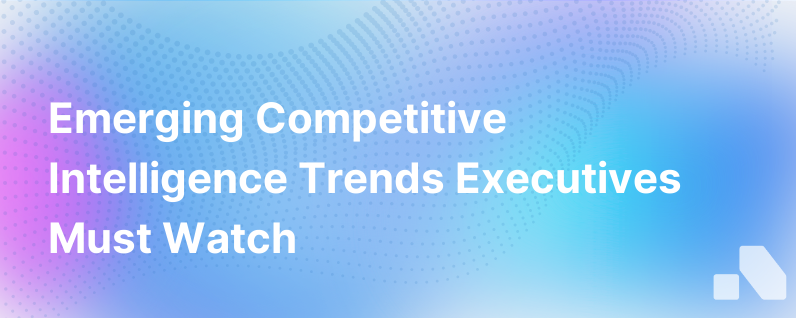
In a digital era where information is omnipresent, having the right insights at the right time is vitale for business success. This fact has driven an evolution in Competitive Intelligence (CI), a discipline aimed at gathering, analyzing and distributing intelligence about products, customers and competitors to support executive and strategic decision-making.
From changes in technology to the advent of artificial intelligence (AI), CI is undergoing shifts that are shaping the way businesses gather, analyze, and use competitive data. In this article, we'll explore the latest trends impacting CI today and how businesses are leveraging these changes to gain a competitive edge.
AI and Machine Learning:
In the era of big data, the role of AI and machine learning (ML) in CI cannot be underestimated. AI and ML can sift through large volumes of data far more efficiently than humans and can also identify trends and patterns that would be almost impossible to detect manually.
By leveraging AI and ML, businesses can generate real-time competitor insights that provide a significant competitive edge. In the realm of CI tools, platforms like Aomni use AI to generate personalized sales content in 15 minutes, providing actionable insights that are critical in today's fast-paced business world.
Increased Focus on Social Media Intelligence:
Social media intelligence – the process of collecting and analyzing data from social networks – has grown increasingly important in CI. This is because social media is a goldmine of insights into competitors' strategies, customer sentiment, and emerging trends.
Social media intelligence can help businesses understand the strategies their competitors are using to engage with audiences, identify potential threats and opportunities, and track brand sentiment in real-time. Leveraging tools and methods to effectively mine social media data is becoming an integral part of modern CI.
Predictive Analytics:
While traditional CI focuses on gathering and analyzing current competitive data, the future of CI lies in predictive analytics. Predictive analytics leverages current and historical data to forecast future competitor behavior.
With the help of predictive analytics, businesses can anticipate competitor's strategic moves, adapt their strategies accordingly, and stay one step ahead in the market. As businesses continue to harness big data, the demand for predictive analytics in CI is set to increase.
Ethical Intelligence Gathering:
As CI becomes more advanced, issues around ethics and privacy have increasingly come to the fore. Companies are being held accountable for how they gather and use competitor data, and ethical intelligence gathering is becoming a significant trend in CI.
This trend involves ensuring that all CI activities are conducted legally and ethically. This means respecting intellectual property rights, complying with data privacy laws, and being transparent about the use of information. As companies push to develop more sophisticated CI capabilities, ethical and legal concerns will continue to shape the CI landscape.
Automated CI Tools:
The CI process is often labor-intensive and time-consuming, involving the collection, analysis, and distribution of vast amounts of data. This is where automated CI tools come in.
Automation in CI involves the use of software to streamline and automate CI tasks such as data collection, competitor tracking, and trend analysis. These tools not only save time and resources but also enhance accuracy and enable real-time insights. Aomni, for instance, delivers real-time account research and competitive insights with practically zero effort required, enhancing productivity and effectiveness in CI.
Integration of CI into Business Strategy:
Traditionally, CI has often been confined to the role of supporting tactical sales and marketing decisions. However, the trend is now moving towards integrating CI more broadly into business strategy.
By integrating CI into business strategy, companies can use competitive insights to inform strategic decisions such as market positioning, product development, and long-term growth planning. This shift is enabling businesses to leverage CI for strategic advantage, making CI an indispensable tool for business success.
Conclusion
The landscape of competitive intelligence is evolving, shaped by advances in technology, changing business needs, and ethical considerations. Forward-thinking businesses are leveraging these trends to enhance their CI activities and gain a competitive edge in today's increasingly complex and competitive business landscape. As we navigate towards an intensely knowledge-driven era, the ability to adapt to these CI trends will define the winners and the laggards.
In closing, tools like Aomni are streamlining this process by delivering real-time, actionable insights powered by AI, leading the revolution in the competitive intelligence space, and guiding businesses to make informed decisions based on accurate, timely, and comprehensive intelligence.